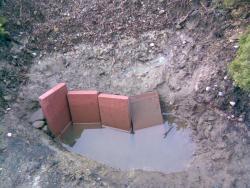On the other hand ...
>> It's a lot easier to kill a plant with too much water than too little.
>> I would suspect over watering also. To much water damages the roots so the plant wilts and then the natural response is to give more water.
I'm a total over-watering junkie, especially in pots and small cells. I've drowned more trays of seedlings than I've planted out successfully. Finally I started making my own seedling and potting mix that drains
really fast . You can't drown roots if the water runs right out the bottom as fast as you pour it in the top!
But that suggests one possible cure you may be able to try IF over-watering or poor drainage might be that plant's problem. (Poor drainage would also make any excessive amount of soluble acid or base or salt EXTRA-harmful.)
If your soil is at all poorly-draining (closer to hard clay than crumbly sand and grit or light, loose, "open" loam) the chemicals and water you add may be puddling around its roots, both poisoning them AND drowning them. The water displaces air and keeps oxygen from perking down to the roots. That kills the roots, fine feeder roots first.
If you water rapidly, like with a hose sprayer set to "shower", does any water accumulate on the surface for a while before draining down or running off?
Do you have a high water table, or brackish water?
When you planted the Hydrangea, did you dig a hole down into very hard, dense soil, and then fill the hole with better soil? (See my first photo, below, where i dug a hole in clay and then watered.)
For water to
flush away the chemicals, it needs to be able to get away. It has to be able to perk pretty quickly through the soil, and most of all, it needs somewhere
downslope to run down TO.
If you soil is sandy or gritty or loose and organic all the way down to some
low water table, you have no problem. Water will drain straight down, dissolving or carrying away chemicals as it goes.
But if you have clay like so many of us, you may have to give some thought and effort to slope or grading, and drainage. (I have a far-gone drainage fetish or obsession.)
If your plant is planted in a low spot, or a perfectly flat yard, little can be done that I know of.
But if it is on a slope or a high spot or near enough to a lower spot, you can dig a slit trench starting just beyond its root zone, and leading down-slope to some lower spot. Going consistently DOWN is key, as I forgot when I started the project you see below (first photo).
If you have seriously dense clay, you might even need to dig out a half-ring around the root ball of the plant, on the down-slope side, and back-fill with something a little better-draining - to help water puddling in the root zone escape from that immediate area and reach the trench. Once it gets that far, it will either run downhill and away, or else drain straight down through the floor of the trench when it hits a well-draining spot.
P.S. The trench only needs a very slight slope, like several inches per ten feet. But if there is any low spot in the trench (a "dip"), that will become the new water-logged spot.





